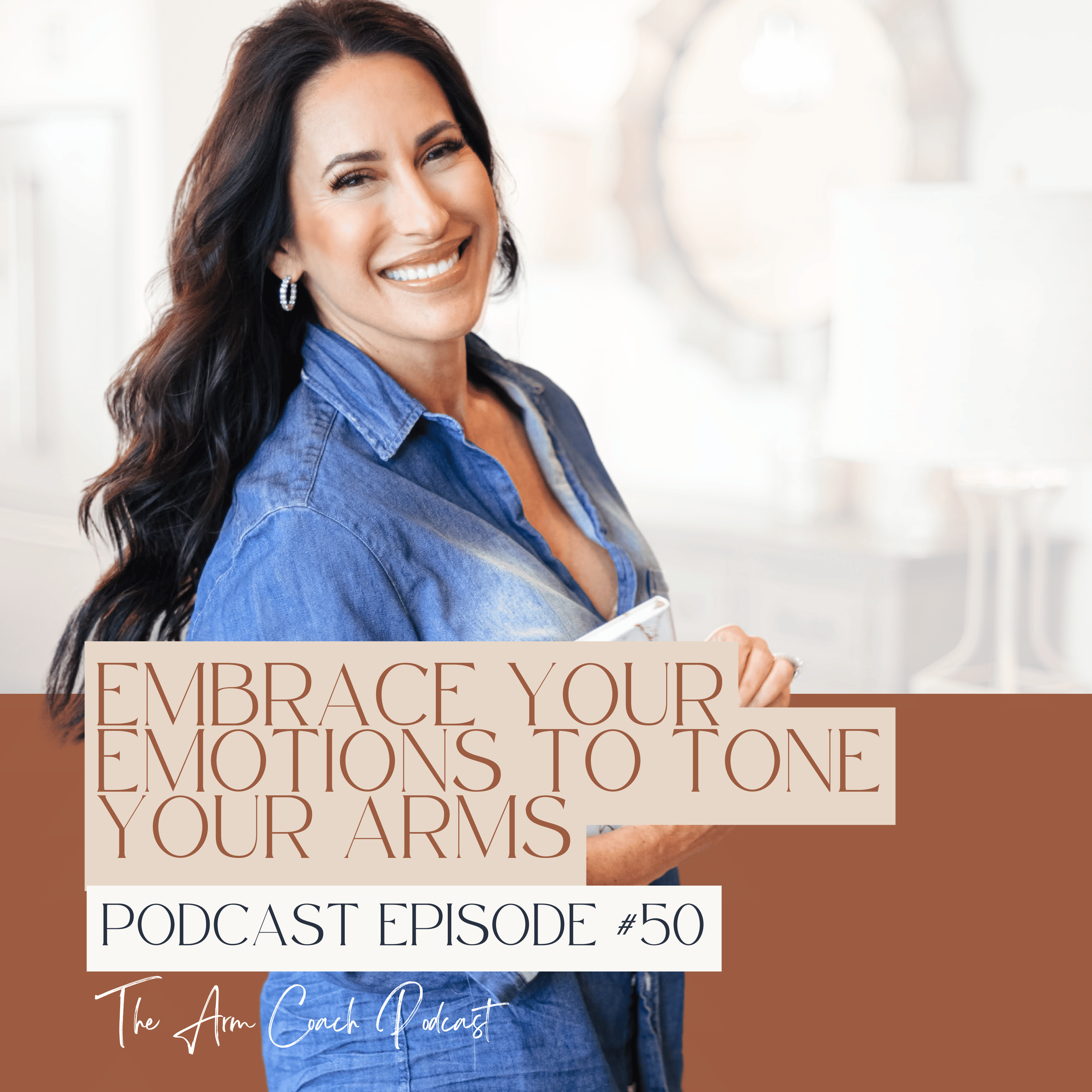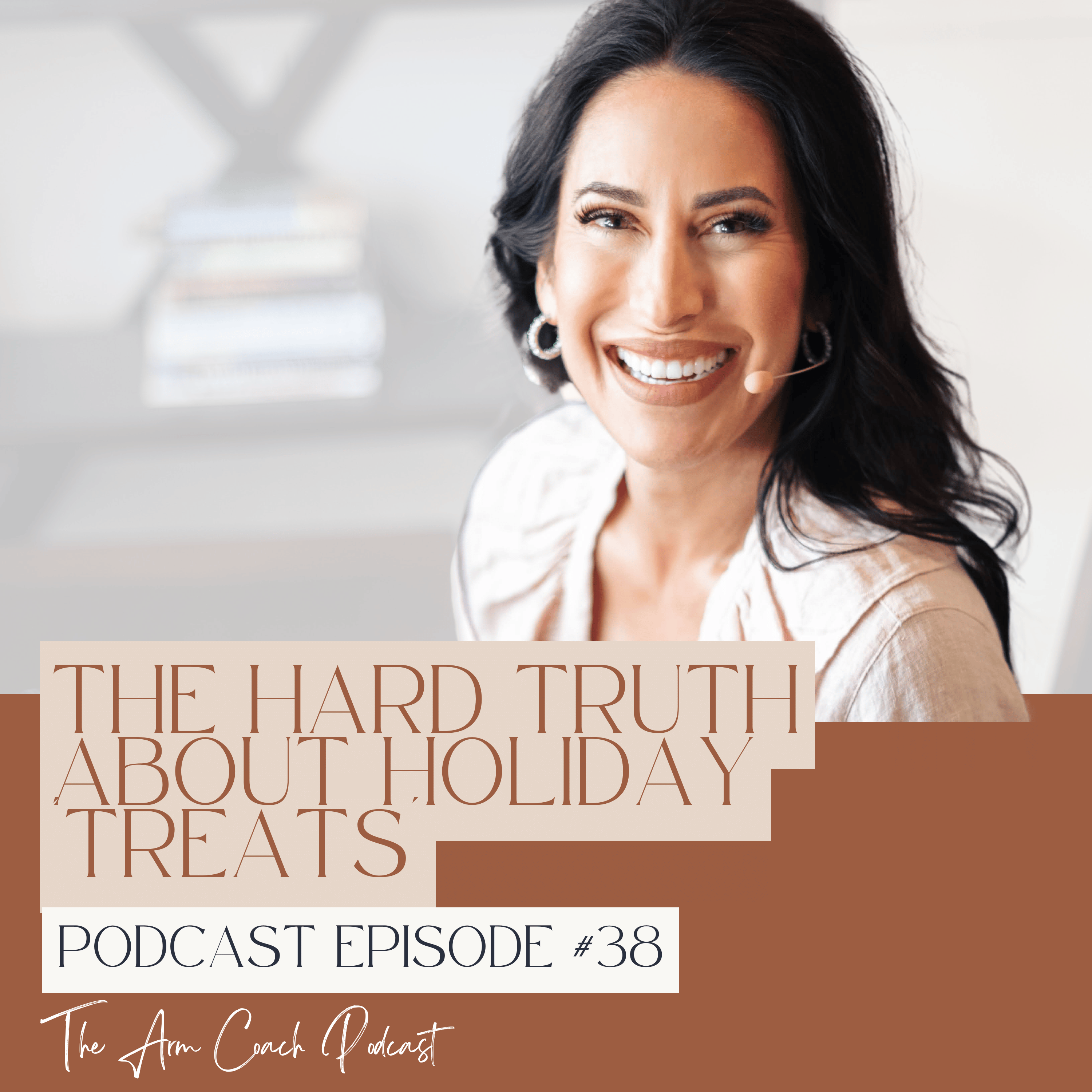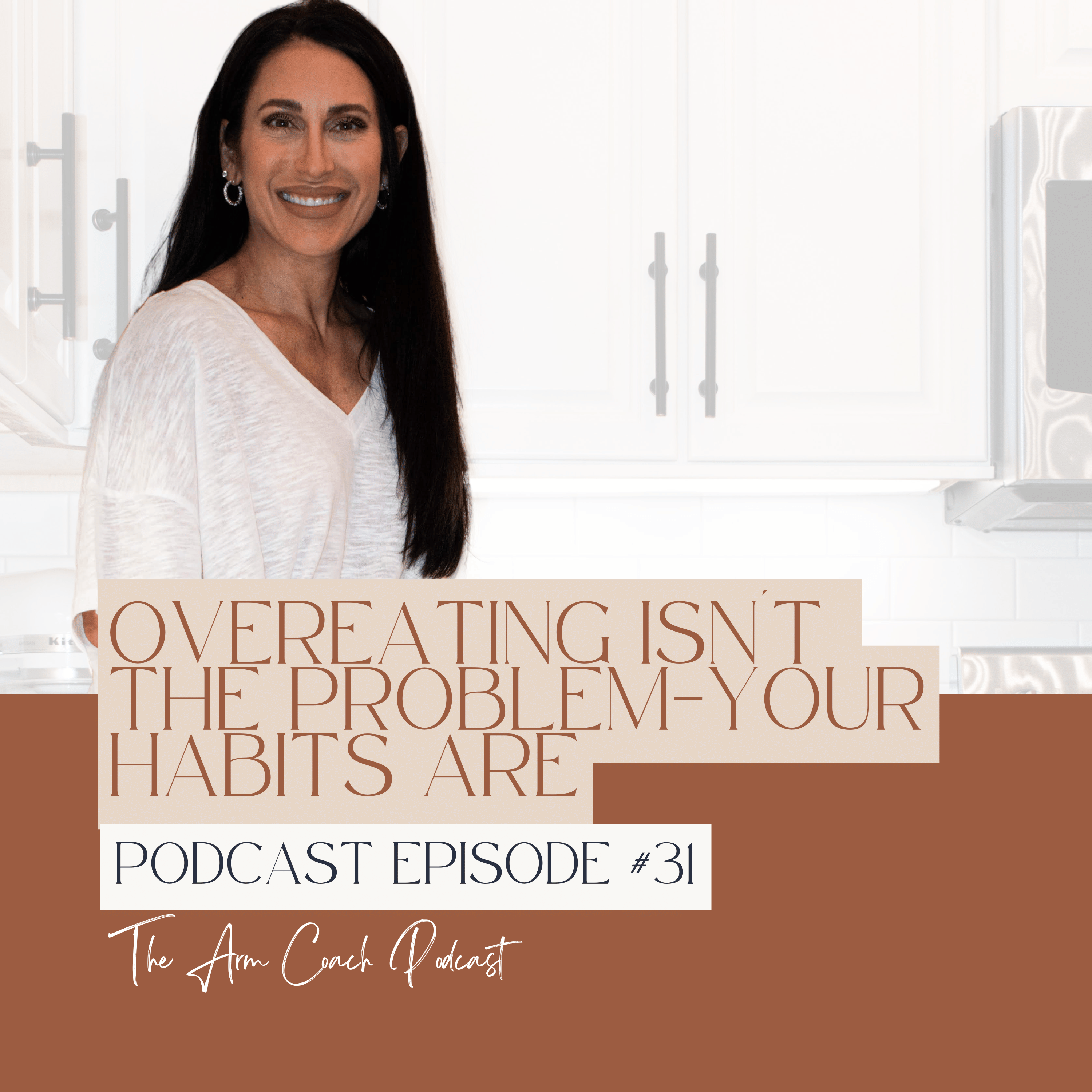Episode Transcript
Let’s face it. We love diets and exercise programs.
We love simple instructions that promise magical results.
Do this and Eat this.
Don’t do that or don’t eat that.
And you’ll arrive at your perfect, sculpted arm results.
Not. True.
Diets and exercise programs are an external solution to an
internal problem.
Today ere talking about why we all love diets and programs,
and love to search for them and read all about them, but
know, inside, that they aren’t the answer to your sculpted
arms.
Hi, everybody, and welcome to The Arm Coach podcast, episode
#30. Welcome back! Today we’re talking about why we all love
exercise programs and diets so much, and what the real answer
to sculpted arms is. I'm your weight loss coach Kristine Rucker
and I'm so happy you’re with me today for another coaching
session. Let's get started.
So first let's talk about what exercise programs and diets are,
because America and the rest of the world seems to be totally in
love with exercise apps and dieting. So exercise programs and
diets are when someone or something outside of ourself, tells us
what exercises to do and how to eat, how much to eat and
exercise, how exercises should be done and how the food
should be prepared. And it's a prescription, it's a prescription of
how to get fit and eat. But exercise programs and diet's on a
ranking of external things and internal things, are really very
external. They're a solution to a problem that's internal, and they
are external. So this is partly why exercise programs and diets
don't work well. They're not really getting at a cause of a
problem. Exercise programs and diets say “do this, eat that,
don't eat this and you'll get this result”. Now, if this worked,
you'd only need one exercise program or diet, right? You'd only
need one book, or one plan. So it's not that the exercises or what
you eat doesn't count. It does. But it's really also a lot of why you
eat and don’t exercise, and why you stop or why you don't stop
eating when your body's had enough. Exercise programs and
Diets, that external prescription of what to do and how much to
eat, don't at all get at the cause of skipped workouts and
overeating. So exercise programs and diets help you deal with
the symptom, and the symptom of your problem is extra weight
and flab on your arms. You try to get rid of that extra weight and
arm flab by changing how you exercise and eat, right? You try to
change how you act, and get rid of the extra weight and arm flab.
But if you remember back in an earlier episode, where we talked
about how our thoughts lead us to take the actions we take, and
give us the results that we get, if we think about this in those
terms, our actions are always created by our thoughts. So if we
try to follow a program or diet, and we try to change what we do,
how we eat, without changing our feelings and our thoughts, we
are definitely bound to fail. If we look at arm weight and flab as
the symptom of a problem, and we look at the whole symptom
and cause relationship, it looks like this. The cause of the extra
weight and arm flab is extra eating and not lifting weights. The
cause of the extra eating and not lifting weights is how you feel
emotionally. The cause of your feelings, good feelings and not so
good feelings, is always your thoughts. And that is what we need
to go back to, to work on, to get to lasting and sustainable
results with sculpted arms. Now we like to tackle this problem of
having extra weight and arm flab by focusing on the action. By
focusing on what do we do, what do we not do, what do we eat,
what do we not eat. And why do we want to do that? Because
that seems easy, it seems direct. “Just tell us what to do”, that's
something that all my clients would love for me to do with them.
Just tell them what exercises to do and what to eat. In fact, there
used to be an old diet book called, Just Tell Me What To Eat.
Literally, that is what we all want. So most of the apps and
books, tell us how to exercise, how to eat, what to buy, how to
cook. In fact, a lot of exercise and diet books have whole big
sections where half of the book is like a cookbook, and it's filled
with recipes. This is the How To section. But if we look at this
kind of advice, it's really outside in, advice. We stick to it as long
as we can. But then we crash because the things that are driving
you to not do your arm exercises, driving you to overeat, are still
creating that drive to not do arm exercises or overeat, to eat
when we have no physical hunger. They don't take us, and the
way that we're thinking and feeling, into account. They’re kind of
created for a generic person, and they don't look at what that
person is thinking. But we love them still, you know, we just all
love anything that will give us five easy steps to fixing a problem.
We love any kind of how to guide. First we do this, then we do
that. The problem is, is that sculpting our arms is not a linear
process. It's kind of all over the place. We can't work backwards.
We can't work from the outside in. In order to resolve this
problem, we really need to work from the inside out. Because the
goal and the number one reason why plans and programs and
diets do not work, is that we need to get at the cause of the
skipped workouts and overeating. Then we could change the
symptom, which is fat and flab on our ams. We can change our
actions and our eating. So if we look at sculpted arms from the
inside out, that means we need to take a look at what drives us
to not do our arm exercises, and to overeat. The fat and flab is
always the symptom. The fat and flab is not the problem. I know
you think that the big problem is ‘My arms are flabby, and in
order for me to be happy, I need to reduce the flab and see
muscle definition’, or whatever it is. But this is not reality. The fat
and flab on your arms is just the symptom of what's going on
inside your mind, inside you're thinking.
I know this is true, because we do not do anything at all, ever,
without having a feeling or a thought first. Any action we take,
always, including skipping workouts and eating without hunger,
always comes from a feeling that you have. And the feeling is
always created on what we're thinking. So if we want to sculpt
our arms, if we want to change our symptom, then we need to go
inside and we need to discover what's causing us to do what we
do to put that fat and flab on. And we need to take a look at the
amounts that we work out and the amounts that we eat. And why
we skip workouts, and why we eat when we eat.
The first thing we need to do when we approach sculpting our arms is to
ask ourselves two important questions: Am I ready to engage with my
body? and Am I truly hungry? These two questions work together to
create a balance between physical training and mindful eating. Before
you pick up a weight or put a bite of food in your mouth, always check
in with yourself.
If the answer to engaging your body is no, pause and explore why—
what’s holding you back from showing up for yourself? And if the
answer to hunger is no, pause again—what’s driving the desire to eat?
Maybe it’s stress, boredom, or an uncomfortable emotion. But if the
answer to both questions is yes, then it’s time to assess: How hungry are
you? What kind of energy do you have for your workout? Put a number
on it. From there, you can decide how to approach your workout—how
intense to go—and how much to eat—when to start and when to stop.
This internal check becomes your natural start-and-stop button for both
movement and eating, guiding you to a more balanced, mindful
approach to toning your arms and fueling your body.
When we overeat or push through workouts mindlessly, we lose that
connection with ourselves. We're not hearing our signals, we’re looking
outside for something else to tell us: the clock, a workout plan, a diet
prescription, or even the tempting food someone else is eating. Maybe
you’re training because you feel you have to or eating because it’s
“time,” regardless of hunger. But when we do this, we’re fighting against
our internal signals. And unless we look at that, and examine what's
driving us, —whether it’s the urge to skip a workout or the desire to eat
when we’re not hungry— we’re fighting ourselves. We're fighting our
own desire.
If you’re not physically hungry, you need to look at why you want to eat.
If you’re not motivated to work out, ask why you’re resisting. Often, it’s
tied to emotions or mental blocks we don’t want to face, so we turn to
food or avoid exercise. Then, instead of addressing the real reason, we
blame ourselves for overeating or skipping a workout. This cycle of self-
blame distracts from the real issue and doesn’t lead to lasting change.
In this case, let’s make up a scenario. Let’s say you set a goal to tone and
sculpt your arms, but something happens that throws you off track—like
a bad day at work. Maybe your boss gave you a performance review that
wasn’t great, and it’s clear that it wasn’t just in your head—it really
didn’t go well. So you might think, “That was awful. I’m failing.” You
start to feel insecure, worried, or ashamed. And what do you do? You
reach for your favorite mind-numbing food and eat to soothe those
feelings. This is how extra weight starts to accumulate on your body, and
then you feel even worse about how you look and your progress. This
cycle of emotional eating and self-criticism repeats itself again and
again.
But what I want you to do is view this as simply a problem to solve—
one that can be addressed with awareness and a different approach.
You’re going to ask yourself: If I wasn’t physically hungry, why did I
eat? What was I feeling when I grabbed that snack and kept going? Most
likely, you were telling yourself something that didn’t feel good—
thoughts like “I’m not good enough” or “I’ll never succeed.” And you
used food to block out those uncomfortable feelings.
If your goal is to stop overeating so you can shed extra weight and feel
more confident in your body, then your mission becomes this: Notice
every time you eat when you’re not hungry, and ask yourself where that
desire came from. Because you know it always starts with a thought. If
you can catch that thought—before you grab food or skip your workout
—you’re in a position to take control. You can then ask, “I eat when I’m
hungry, so what’s really going on here? What do I actually need?”
If you don’t ask these questions, it’s like having a broken arm and trying
to fix it with a small band-aid. That band-aid won’t heal what’s
happening inside. And just like that band-aid won’t fix a broken arm,
food won’t fix a painful emotion. It’s the wrong solution for the problem
you’re facing.
That wrong solution—extra food or skipping your workout—leads to
two things, and neither of them is relief. First, it adds extra weight to
your body, moving you further from your goal of toned arms. Second, it
fills your mind with negative thoughts, making you feel bad about
yourself. You feel stuck in a cycle of doing something you don’t want to
do, and you don’t know how to stop.
But by shifting your focus inward, you can start to recognize these
patterns. Instead of using food to escape uncomfortable emotions, or
avoiding a workout because of self-doubt, you’ll be able to address the
real issue and create lasting change—both in your body and your
mindset.
This is why, when it comes to sculpting your arms and managing your
body, you always want to go inside to see what’s causing the extra
weight or resistance, instead of putting a bandaid on the problem. Just
like a diet doesn’t fix emotional eating, forcing yourself through a
workout without addressing what’s really going on mentally won’t lead
to lasting results. When you take care of your thoughts and emotions on
a regular basis, there’s no overeating or skipping workouts to escape
anything. You’re working out and eating for the purpose they were
created—food to nourish your body and exercise to strengthen and
sculpt it. And yes, workouts should be empowering, and food should be
delicious.
Now that you understand that the inside solution—working on your
thoughts—is the answer, you’ll see that no more eating to feel better and
no more “forcing” workouts are necessary. We’re not relying on a strict
diet or rigid exercise plans to achieve toned arms. When you focus only
on external actions like dieting or exercising just because you think you
have to, without understanding the emotions or thoughts driving your
behavior, it’s like slapping a band-aid on a broken bone.
If your overeating or skipping workouts isn’t caused by something
external—like a stressful day at work or a family conflict—then simply
eating less or forcing yourself to work out won’t solve the problem or
make you feel better. The real solution comes from addressing the
internal cause. If you’re avoiding your workout because you’re feeling
stressed, overwhelmed, or discouraged, that’s where you need to focus.
When you learn how to feel good in your life without turning to food or
avoiding exercise, you’ll stop looking for the next “magic” solution to
get toned arms. You’ll stop relying on external fixes like crash diets or
punishing workout routines. Instead, you’ll know that to achieve your
goals—whether it’s losing extra weight or building strength in your arms
—you need to go inside and figure out what you’re thinking and feeling
that’s causing you to overeat or resist showing up for yourself again and
again and again.
I know I’ve given you a lot to think about. And if you’re like many of
my private clients, you might feel a little disappointed, wishing there
was some secret workout plan or diet that would magically tone your
arms, no matter what you were thinking or feeling. But the truth is,
lasting results come from addressing the real cause of your habits—
whether it’s overeating or skipping workouts—not from trying to patch
things up with external fixes.
So, for now, take some time to reflect. When you catch yourself
searching for that magic solution and not finding it, remember to look
inward instead. I truly appreciate you, and I hope you keep giving
yourself the gift of these lessons—treating them like your own personal
coaching session.
So this is why you always want to deal with extra weight by going
inside to see what's causing it, instead of putting that bandaid on
the broken bone. When you take care of your thoughts and your
emotions on a regular basis, there is no extra weight gain,
because you aren't eating to escape anything. You're eating only
for the purpose food was created, because it feeds you. It
nourishes you and yes, it should taste delicious.
So now you know that the inside solution, working on your
thoughts, is the answer. No more eating to feel better and not
trying to control that eating with a diet, because then we're
working on the outside, instead of the inside. If the extra eating
that you're doing doesn't come from the external world, you
know something that happens in your world, then eating less
isn't going to make you feel better in that world. It will come from
applying an internal solution to your extra weight, not a diet. And
when you learn how to feel good in your world without extra
food, then you will eventually stop looking for the magic diet to
manage your weight. You will know, truly, that to lose extra
weight, you'll know that you need to go inside and figure out
what you're thinking, that's causing you to overeat again and
again and again, and gain extra weight.
I know I've given you a lot to think about. I know that if you're
anything like my private clients, you're maybe a little
disappointed and you kind of wish that there was some secret
diet that nobody else knew about, that would work, no matter
what you were thinking or feeling. So just think about dealing
with your extra weight by getting at the cause of it, the cause of
the overeating, instead of trying to patch it up from the outside in.
So, on this subject, that’s all for right now. Please let me know
how you do when you habitually want to keep looking and
searching for that external solution, and you can't find it. I really
appreciate you and I hope that you keep giving yourself the gift
of these lessons, and that you treat it like your own private
coaching session.


